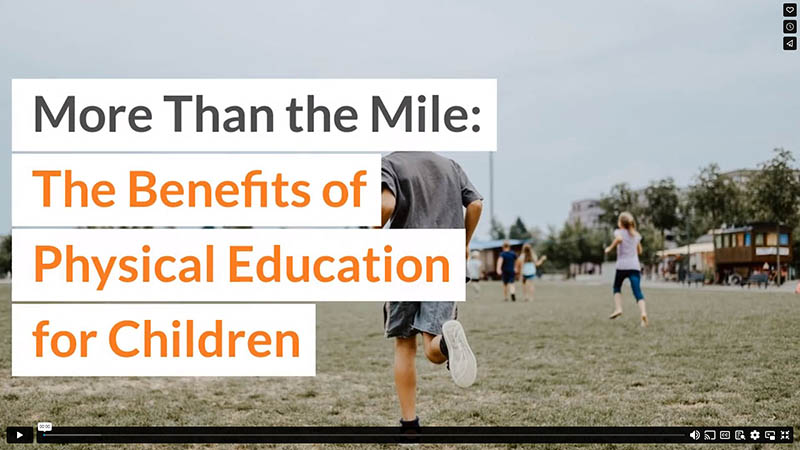When you think of physical education, you might picture gym shorts, fitness exams, and the dreaded mile run. But according to our Atlanta elementary and middle school P.E. teachers, there is so much more to it than those things, and its benefits extend far beyond those of simply being physically ‘fit.’ When children participate in physical education at school, the effects reach every area of their lives, encouraging physical, emotional, and social development.
The CDC recommends “that children and adolescents ages 6 through 17 years do 60 minutes (1 hour) or more of moderate-to-vigorous physical activity daily.” In a world where children are prone to spending hours each day in front of a screen (an average of 7.5 hours daily, according to the CDC), it is more important than ever to help children develop healthy habits and an appreciation for physical activity and its many rewards and benefits.
Health
First and foremost, physical education encourages healthy body weight, muscular strength, endurance, flexibility, bone density and cardiovascular stamina. Through P.E. classes, children also learn about healthy habits such as rest and nutrition. In addition, physically active children are less likely to develop type 2 diabetes and other issues related to cholesterol and blood pressure.
P.E. is also a great way to get kids out of the classroom and into the sunshine when the weather permits. Many children who spend more time playing outside develop better eyesight and increased mental and physical health due to bright light exposure.
Lastly, children who are regularly active as they grow up are more likely to become physically active adults. This, in turn, becomes a tool that can combat obesity, chronic illness, and even mental illness long into adulthood. Therefore, children must learn not simply the elements of physical education but the value of keeping these habits long after graduation.
Motor Skills
The skills practiced in physical education are also essential tools for developing and improving motor skills such as balance, coordination, and agility. According to a 2020 National Library of Medicine study, physical education is “an important context for developing a broad range of motor skills.” These skills fall into three categories:
- Locomotor: any action that moves the body from one place to another, such as walking, running, jumping, and skipping.
- Non-locomotor: action performed in one place, such as bending, twisting, stretching, pushing, pulling, flexing, raising, and lifting.
- Manipulative: action involving another object. These actions include throwing, kicking, catching, dribbling, striking, and punting.
Physical education is essential to developing these crucial skills, which comprise the building blocks not only for sports but for everyday activities as well.
Social Skills and Character Development
Along with the physical benefits of P.E., it is also an excellent way for children to learn crucial life skills such as teamwork, cooperation, problem-solving, communication, leadership, and discovering the value of delayed gratification.
A recent Sage Journal Publication studied the correlation between physical education and social skills with widely positive results. One aspect of the study found that students participating in physical education showed an increased ability to practice self-control and displayed increased coping skills, resilience, and time management.
Through sports and group activities, children learn to work together toward a common goal, recognize their strengths and areas for improvement, and learn to recognize and value the strengths of their peers as well. They also learn to handle both the pride of winning and the disappointment of losing. Yes, even if that means crying it out on the soccer field.
Mental Health
When children see personal improvement in their motor skills and fitness, their feelings of competency soar. This, in turn, helps children to become more motivated, driven, and optimistic toward physical activity. Physically active children also show improved brain function and focus. Here they learn to regulate energy and emotions to succeed in the gym and in the academic classroom.
Additionally, regular physical activity has been known to reduce depression, anxiety, and stress in children and adults, boosting mood and self-esteem. Instilling these habits early on will better prepare children to become mentally healthy adults. The Committee on Physical Activity and Physical Education summarizes that “the promotion of more physical activity and quality physical education in the school setting is likely to result in psychosocially healthier children who are more likely to engage in physical activity as adults.”
When we look at the big picture of a child’s life, we see that a physically active lifestyle is essential to their overall well-being. It’s up to parents and teachers to instill these important values and habits in children as early as possible and allow them to see the importance of continuing them as they reach adulthood.
Video

Infographic
Physical education (PE) is vital for holistic child development, building a foundation for a healthy body, and fostering essential motor and life skills. Outdoor activities enhance well-being. PE also boosts children’s mental health, enhancing focus and reducing stress. Instilling these habits early is key to lifelong well-being, with parents and teachers as health-promoting superheroes.

